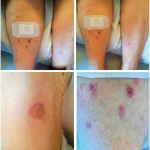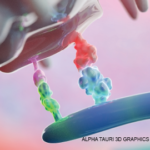
Cancer cells
SAN DIEGO—New insights into how scleroderma and myositis may be linked with cancer have led to intriguing questions that could impact patient care, experts said at the 2017 ACR/ARHP Annual Meeting in November.
Understanding the relationship between cancer and rheumatic diseases is important because rheumatologists are seeing more and more patients with both diseases, and treating both conditions at the same time poses a challenge, said Ami Shah, MD, MHS, director of clinical and translational research at the Johns Hopkins Scleroderma Center in Baltimore.
Researchers have found that scleroderma patients with anti-RNA polymerase-3 (POL3) or anti-RNPC-3 antibodies, and myositis patients with TIF1-gamma or NXP-2 antibodies, are more likely to develop cancer right around the time of the onset of their rheumatic disease. And evidence has emerged that naturally occurring anti-tumor immune responses directed at altered autoantigens in cancers may spread, possibly giving rise to these autoimmune disorders.
Antibody subsets can help define a patient’s cancer risk, Dr. Shah said. For example, she and her colleagues found that relative to patients with anti-centromere antibodies, scleroderma patients with anti-POL3 or anti-RNPC3 antibodies carried a fourfold risk of developing cancer within a short interval of scleroderma onset.
In other research, among 213 dermatomyositis patients assessed at Hopkins and Stanford University, 83% of those with cancer-associated dermatomyositis were identified by anti-NXP-2 or anti-TIF-1-gamma antibodies.
But many questions remain, Dr. Shah said.
“Is aggressive cancer screening warranted in these patients, and does early cancer detection improve both cancer and rheumatic disease outcomes?” she said. So far, we don’t have much hard data to answer this.
Can Cancer Treatment Affect Autoimmune Disease?
In one intriguing case recently published, a 43-year-old woman with diffuse scleroderma and polymyositis overlap with anti-PM/Scl antibodies, was found to have a solid pseudopapillary pancreatic neoplasm. When the cancer was resected—she didn’t receive chemotherapy—she was quickly weaned off immunosuppression, and her skin thickening and myositis resolved.
“If rheumatic diseases may be a manifestation of an underlying cancer, could cancer therapies [treat] rheumatic disease?” she asked. “I think at the end of the day, this is the question we all really care about.”
The session also covered the challenges and risks of using immune checkpoint inhibitors with autoimmune diseases. The growing use of immune checkpoint inhibitors (ICIs) for all types of cancer poses a particular challenge for rheumatologists, said Laura Cappelli, MD, MHS, assistant professor of medicine at the Johns Hopkins Arthritis Center in Baltimore, Md. The drugs work by blocking negative costimulatory molecules—essentially, “taking away the stop light,” she said—and boosting T cell activation. There are six FDA-approved ICIs, with even more tumor types, drugs and combinations likely to enter the fray.
Because rheumatic disease therapies tamp down immune responses, the question, Dr. Cappelli said, is, “What happens when the forces of immune activation outweigh those of inhibition? … Unfortunately, with these immune checkpoint inhibitors, there’s no free lunch.”
ICIs can cause a wide array of immune-related adverse events (irAEs), affecting all body systems. Such events can range in severity and in timing, but combination ICI treatment tends to lead to more common events of all types, Dr. Cappelli said.
In a systematic review published in 2016, the four most common irAEs were found to be inflammatory arthritis, sicca syndrome, polymyalgia rheumatica and giant cell arteritis (PMR/GCA), and myositis.3
A guideline for how to handle inflammatory arthritis that emerges with ICI therapy was published last year. Its authors suggested that in the mildest cases, physicians should continue the immunotherapy, with NSAIDs and consideration of prednisone or intra-articular steroids. For moderate cases, they also suggest continuing immunotherapy at first, but to consider holding it if there’s no response to oral prednisone after at least four weeks. In severe cases, they suggest holding immunotherapy, trying oral prednisone for four weeks, and then considering TNF inhibitors or methotrexate.
Sicca is treated with saliva substitutes, sialogogues, artificial tears and other therapies. In PMR/GCA, Dr. Cappelli said, inflammatory markers are almost always elevated, with corticosteroids the mainstay treatment. And in myositis, ICIs are held or stopped in almost all cases, with corticosteroids as the standard treatment.
‘What happens when the forces of immune activation outweigh those of inhibition?’ —Dr. Cappelli
Can Immunosuppression Affect Cancer Treatment?
Dr. Cappelli said rheumatologists and oncologists have concerns about giving immunosuppression to treat irAEs.
“[The] first, and I think the foremost, worry is, are we abrogating the anti-tumor effect of the immune checkpoint inhibitors? Are we impairing natural tumor defenses, and are there overlapping side effects?” she said. “Ultimately, it’s a multidisciplinary discussion to decide on treatment because there’s limited data in the published literature.”
Can patients with autoimmune disorders who develop cancer be treated with ICIs? Patients with rheumatic diseases were excluded from the original clinical trials, so there’s not much data to go on, she said.
One case series found eight of 30 melanoma patients with a variety of rheumatic conditions had an exacerbation of the underlying illness, with most managed with steroids but with two inflammatory bowel disease patients needing infliximab. In another case series, 20 of 52 melanoma patients had a flare of their autoimmune condition that required immunosuppression, and two discontinued their ICI because of the flare.
“The limited data shows there are better outcomes if they’re controlled at the start” of the ICI treatment, Dr. Cappelli said.
Moving forward, she said, the field needs better understanding of the epidemiology of rheumatic irAEs and of the relevant immune pathways to know how best to maintain an anti-tumor response while minimizing irAEs. We also need long-term follow-up of those needing immunosuppression for irAEs, and “rational design” of treatment algorithms, Dr. Cappelli said.
“Many areas need more investigation for us to best care for these patients.”
Thomas R. Collins is a freelance writer living in South Florida.
References
- Shah AA, Xu G, Rosen A, et al. Brief Report: Anti-RNPC-3 antibodies as a marker of cancer-associated scleroderma. Arthritis Rheumatol. 2017 Jun;69(6):1306–1312.
- Fiorentino DF, Chung LS, Christopher-Stine L, et al. Most patients with cancer-associated dermatomyositis have antibodies to nuclear matrix protein NXP-2 or transcription intermediary factor 1γ. Arthritis Rheum. 2013 Nov;65(11):2,954–2962.
- Cappelli LC, Gutierrez AK, Bingham CO 3rd, et al. Rheumatic and musculoskeletal immune-related adverse events due to immune checkpoint inhibitors: A systematic review of the literature. Arthritis Care Res (Hoboken). 2017 Nov;69(11):1751–1763.



